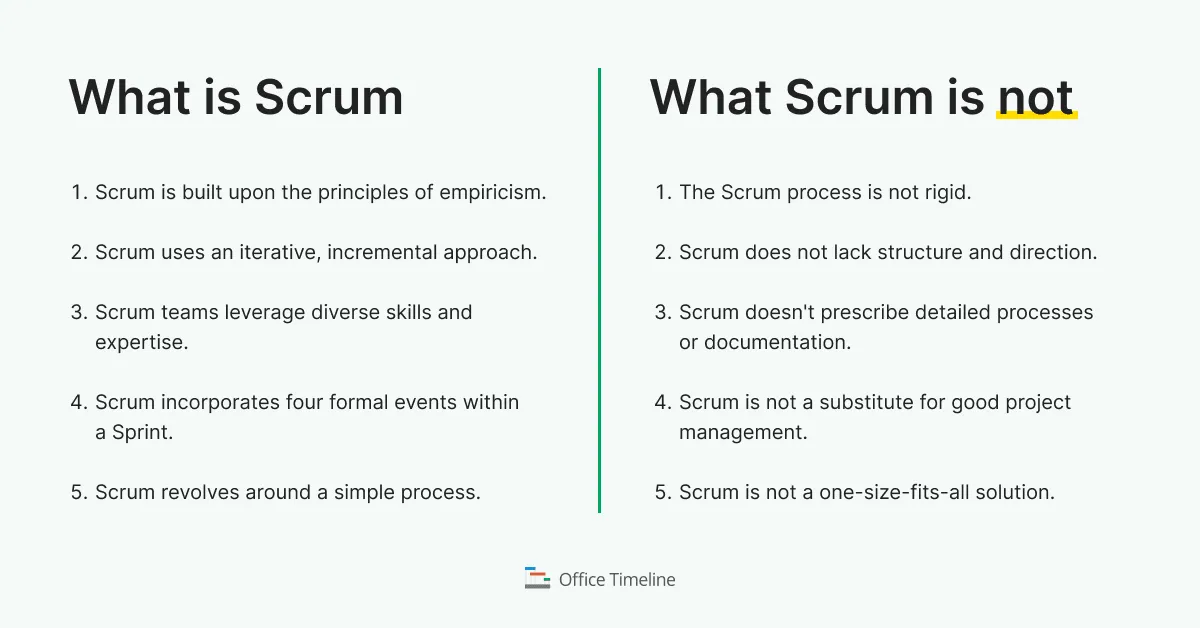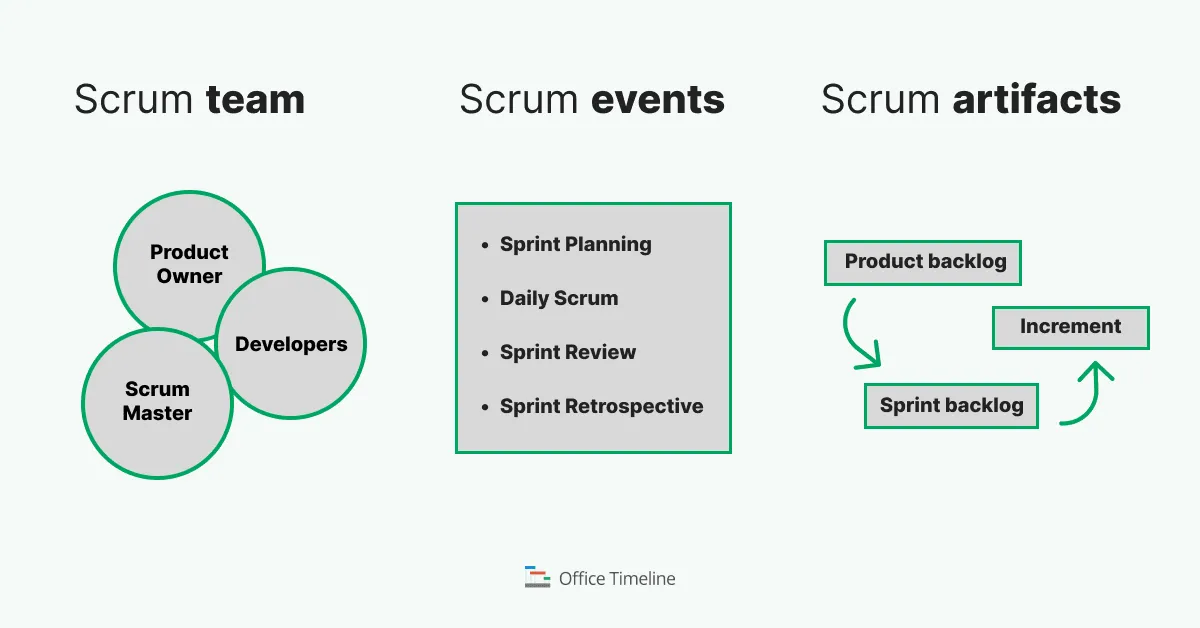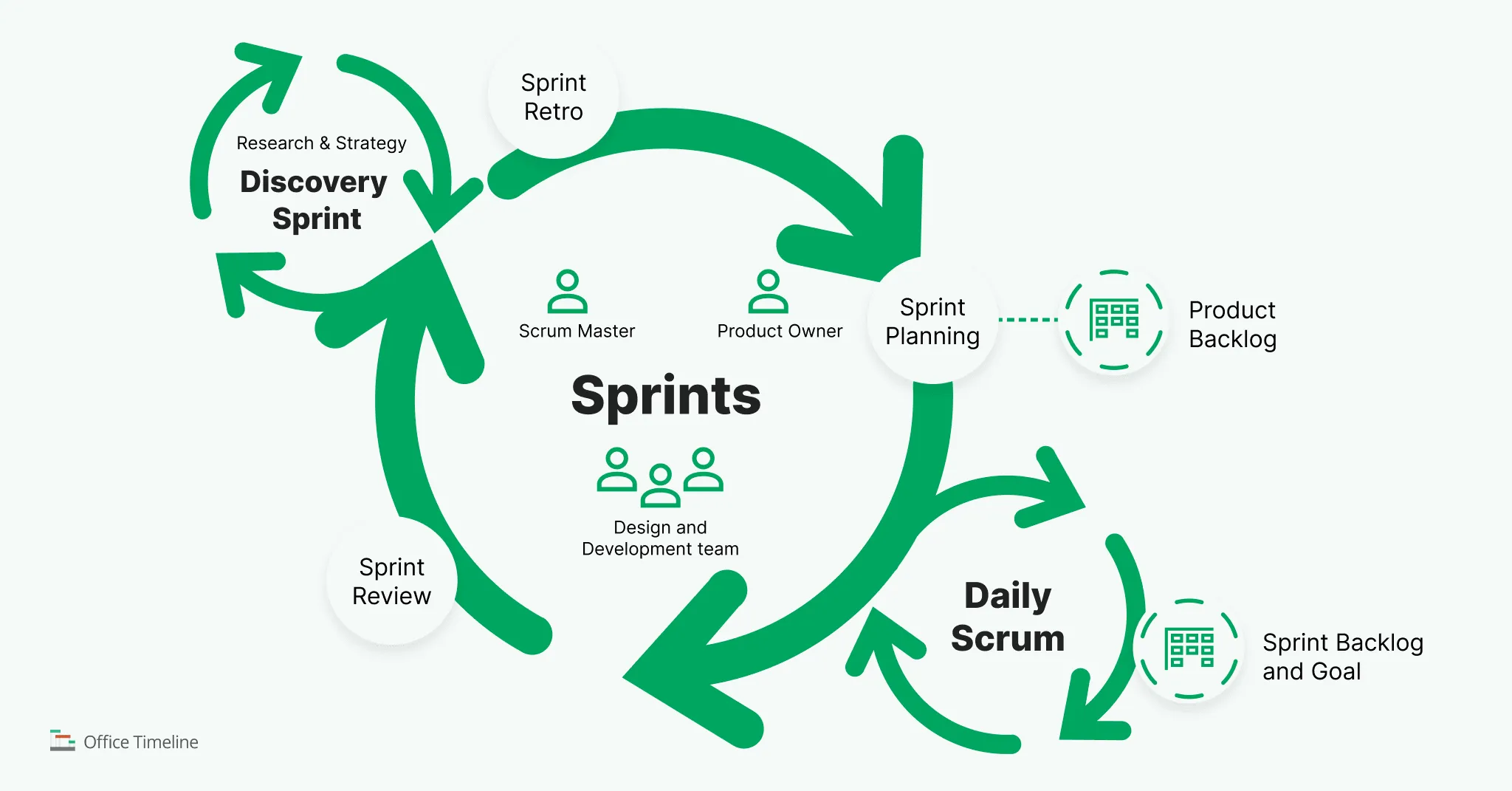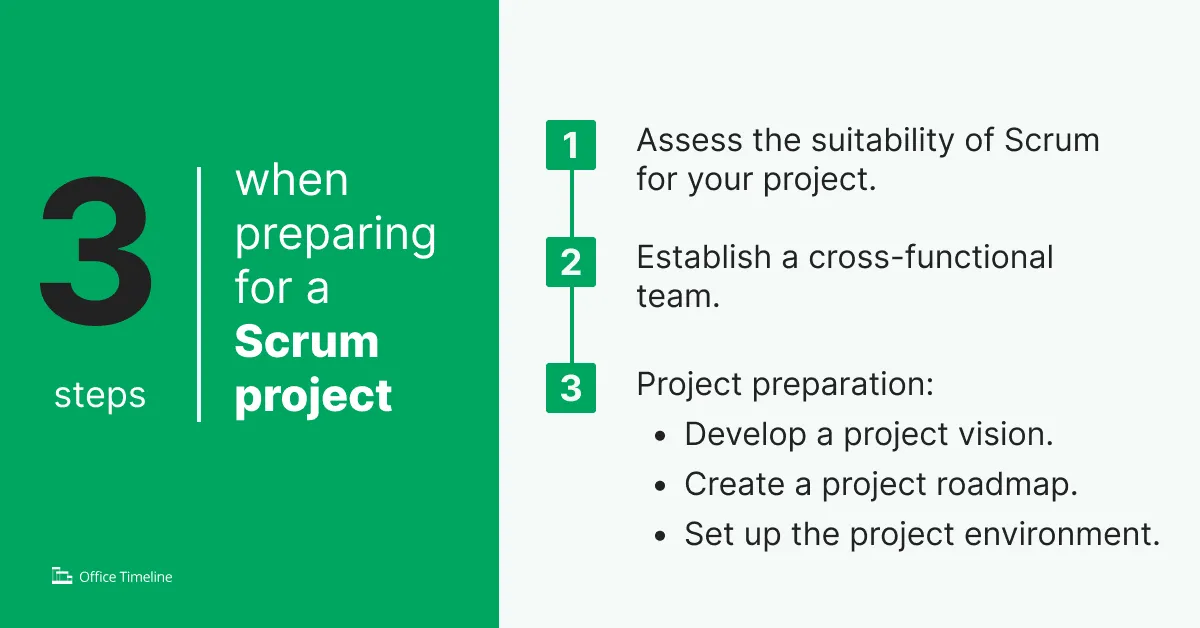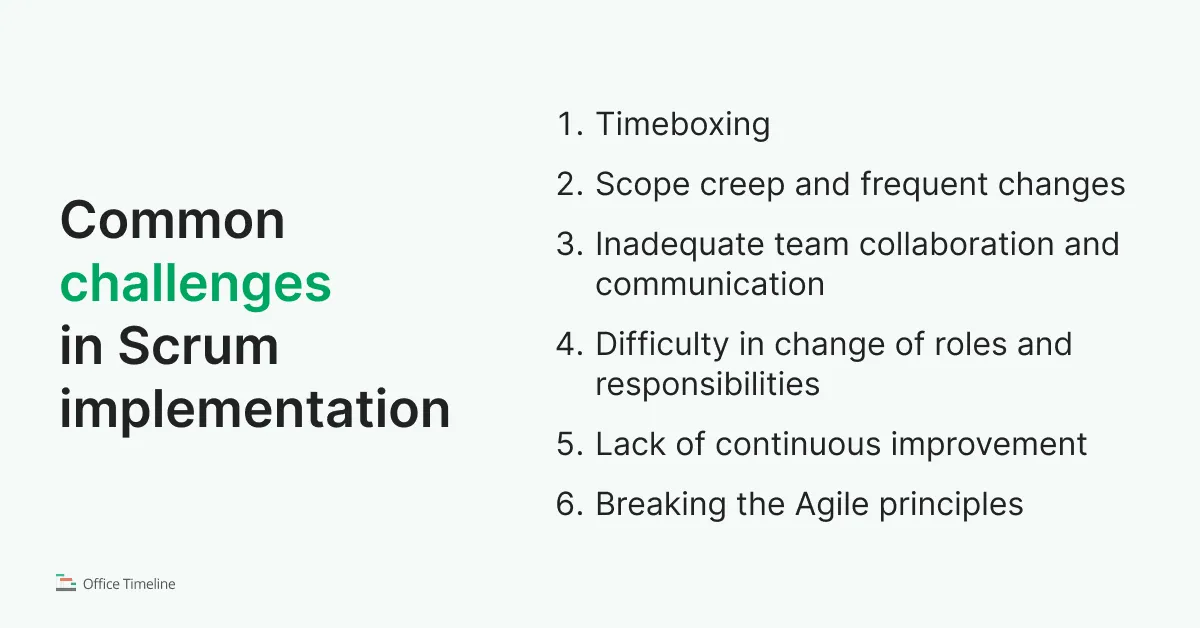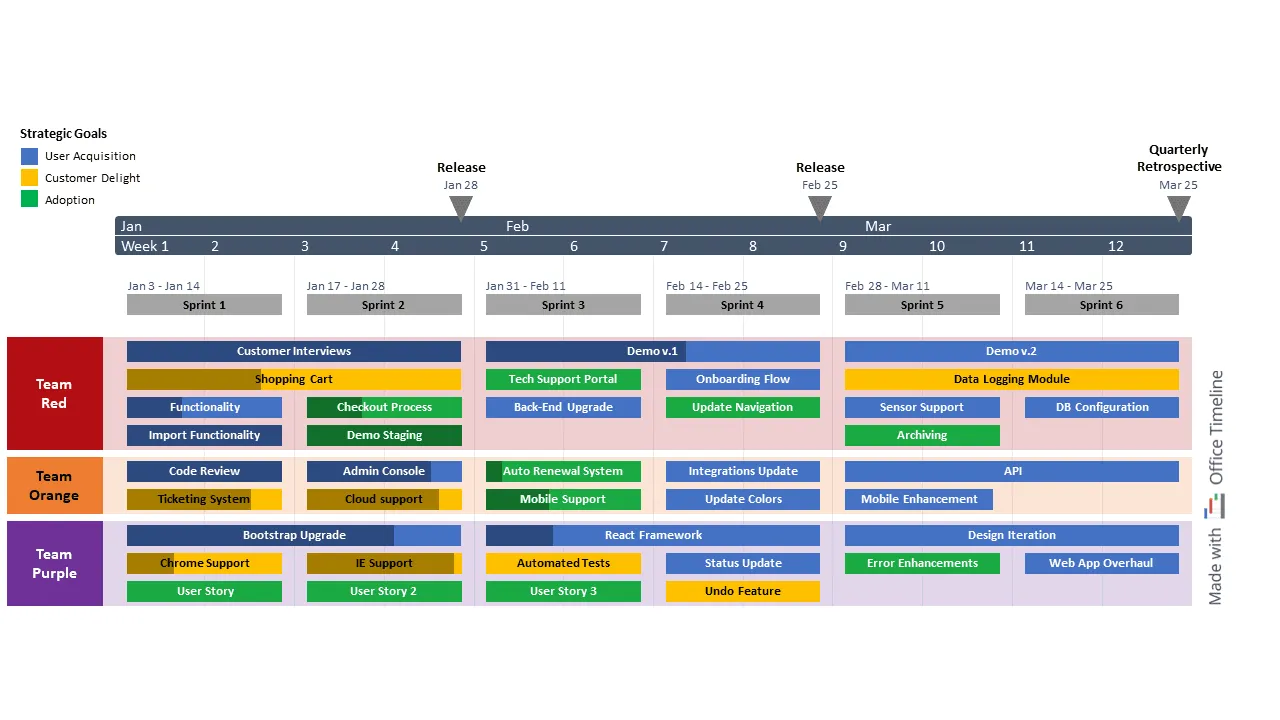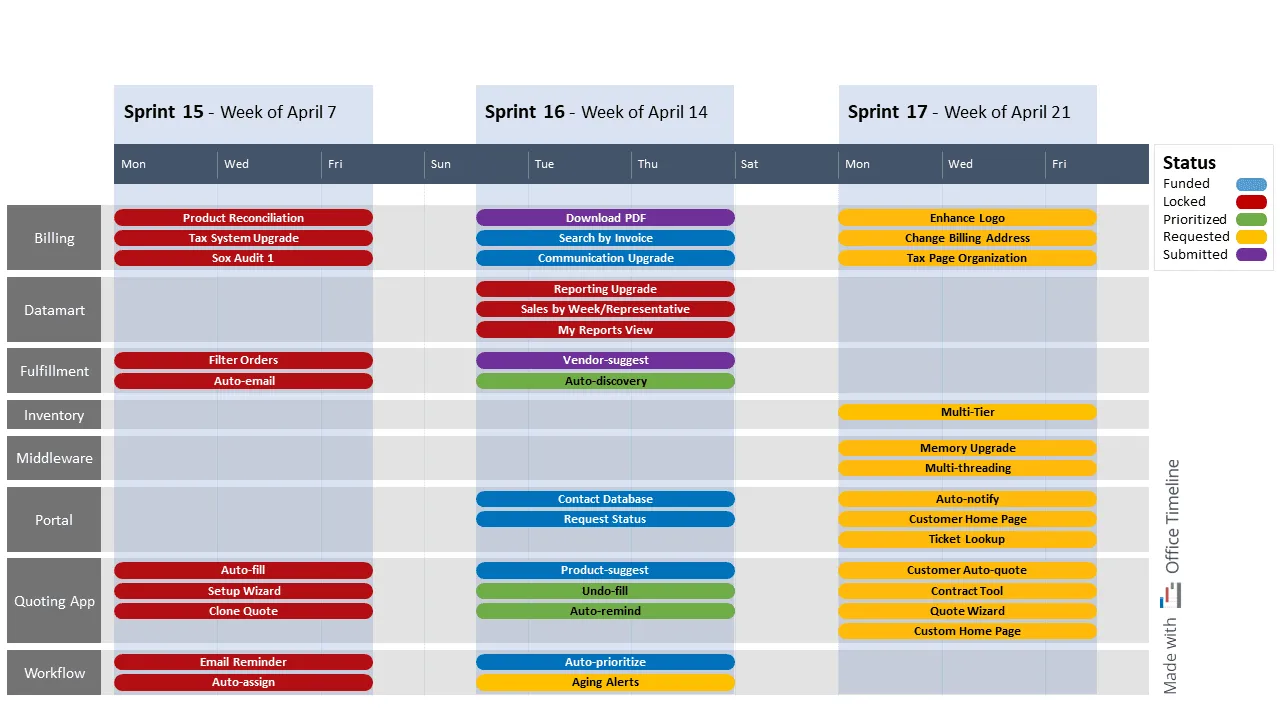Mastering Scrum. Essential guide for Agile teams
Gain insights into Scrum methodology, overcome common challenges, and download free PowerPoint templates to optimize your Agile projects.
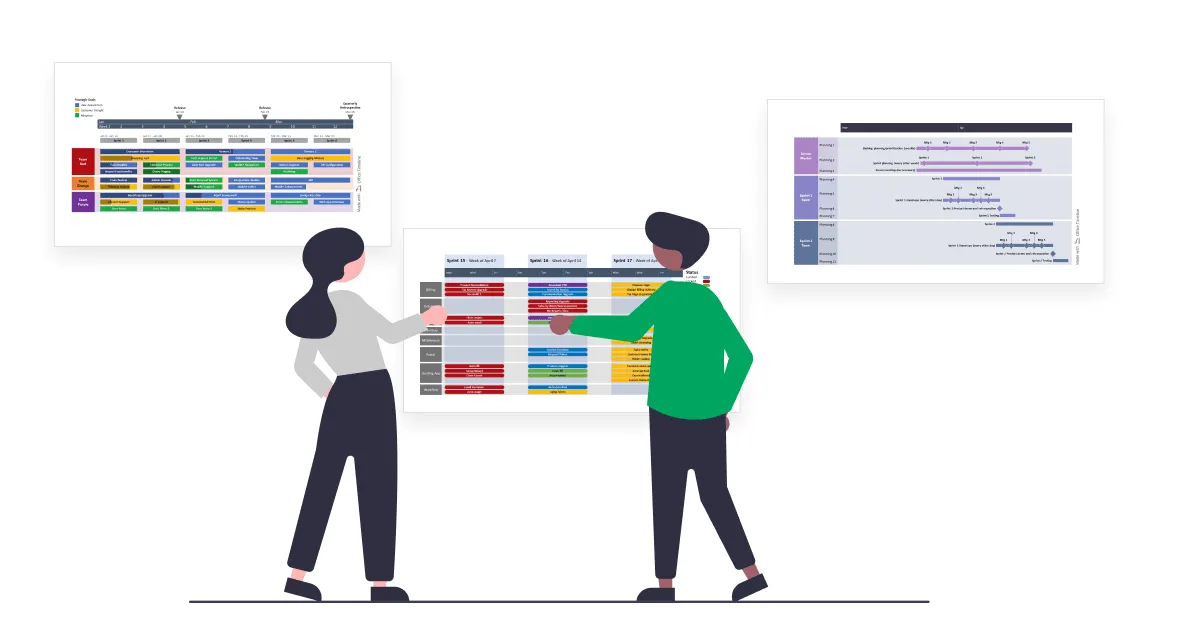
While Scrum has been around for several decades, revolutionizing the world of agile project management, some basic aspects are often overlooked or misinterpreted. In this article, we aim to shed light on these often-neglected areas and provide insights that will enhance your understanding of Scrum.
Whether you’re on your way to getting the Scrum Master certification, working towards implementing Scrum in your organization, or looking to improve your Agile techniques, this article is the perfect starting point. Discover practical guidance for applying Scrum proficiently, along with some free templates to jumpstart your Scrum project planning.
1. Scrum fundamentals
Scrum is a simple framework that enables the iterative and incremental development of complex products. According to The Scrum Guide™ ,
Scrum is a lightweight framework that helps people, teams and organizations generate value through adaptive solutions for complex problems.
At its core, Scrum prioritizes adaptability in value creation while empowering teams through autonomy, self-organization, collaboration, and accountability.
1.1. The origins of Scrum: Brief history
The concept of “scrum” is derived from rugby. In rugby, a scrum is a formation of players working together to gain possession of the ball. In product development, the term is used to emphasize the agility and the collaborative, team-oriented nature of the Scrum framework.
Agile methodologies emerged in response to the limitations of the Waterfall model (created by Winston W. Royce back in 1970), which followed a linear, rigid sequential flow, struggled to accommodate changing requirements, and lacked frequent customer involvement.
Let’s explore the key milestones that have shaped the history of Scrum with this visual timeline made with Office Timeline:
Scrum history: key milestones
- 1986: The term “Scrum” was first introduced in a 1986 paper, “The New New Product Development Game” by Hirotaka Takeuchi and Ikujiro Nonaka, which was published in Harvard Business Review. It originates in the real-life strategy of companies like Fuji-Xerox, Honda, and Canon and states that the new way to develop products needs to rely on speed and flexibility, “as in rugby, the ball gets passed within the team as it moves as a unit up the field”. “Under the rugby approach, the product development process emerges from the constant interaction of a hand-picked, multidisciplinary team whose members work together from start to finish.”
- 1993: Jeff Sutherland, John Scumniotales, and Jeff McKenna from the Easel Corporation introduced Scrum to teams, drawing inspiration from Takeuchi and Nonaka’s paper. Their adaptation led to the full development of the concept of “Scrum” as it is recognized today.
- 1995: At the Object-Oriented Programming, Systems, Languages & Applications (OOPSLA) Conference, Ken Schwaber and Jeff Sutherland introduced Scrum, presenting their accumulated knowledge and providing the initial formal definition of the framework in the paper “The Scrum development process”.
- 2001: The Agile Manifesto is drafted and endorsed by Sutherland, Schwaber, and fifteen colleagues, emerged as an alternative to documentation-heavy and cumbersome software development. With four values and twelve principles, it remains the bedrock of agile software development to this day. The same year, Ken Schwaber and Mike Beedle published the first Scrum book, “Agile Software Development with Scrum”.
- 2002: The Scrum Alliance is founded by Ken Schwaber along with Mike Cohn and Esther Derby.
- 2006: Jeff Sutherland creates his own company, Scrum.inc, where he continues to provide and teach the Certified Scrum courses, including Certified ScrumMaster (CSM) and Certified Scrum Product Owner (CSPO), in collaboration with Scrum Alliance.
- 2009: Ken leaves the Scrum Alliance and founds Scrum.org with the aim of enhancing the quality and efficacy of Scrum methodologies through the Professional Scrum series.
- 2010: The first Scrum Guide is published, serving as a definitive resource on Scrum. Developed by Jeff Sutherland and Ken Schwaber, the Scrum Guide remains the authoritative reference for Scrum methodologies.
- 2011-2017: Incremental updates to The Scrum Guide were made in 2011, 2013, 2016, and 2017.
- 2020: The updated version of The Scrum Guide is released. It is the latest and sixth version of the Scrum Guide. This iteration prioritizes the simplification of the framework, ensuring greater usefulness and improved efficiency for teams.
1.2. What Scrum is and what it is not
Scrum promises faster delivery of value, adaptability and continuous improvement in project execution, while focusing on empirical process control and enabling collaboration through structure. It is a simple framework with the goal to deliver valuable solutions through a dynamic approach that welcomes change in the face of complex situations.
No wonder that Scrum has become the most adopted Agile framework. Based on the 16th State of Agile Report (2022) by Digital.ai, Scrum is the preferred Agile framework for 87% of organizations. Agile project management methodologies (e.g., Scrum, Kanban, Lean Software Development, Extreme Programming, etc.) prioritize flexibility, cross-functional collaboration and iterative development.
Scrum stands out by providing a structured framework that promotes clear roles, events, artifacts, and further emphasizing iterative development through time-boxed sprints. This allows for frequent inspection and adaptation, enabling teams to continuously improve and adapt responsively to changing requirements. But are these valid arguments to adopt Scrum in any circumstance?
Let’s delve into the essence of Scrum and find out why its impact varies in different contexts.
What is Scrum?
First things first. The definition of Scrum in The Scrum Guide starts with: “Scrum is a lightweight framework”. Why? Because Scrum provides a minimalistic approach to project management. Unlike rigid methodologies, Scrum focuses on simplicity and flexibility, offering a lean set of guidelines. Its simplicity and flexibility make it adaptable to various projects and environments.
The definition further describes Scrum’s mission: it enables teams to create value by developing adaptable solutions for complex problems. Like a sports team, Scrum empowers teams to manage themselves, learn from experience, and adapt to change.
The Scrum theory (in The Scrum Guide) establishes the fundamental aspects of the Scrum framework:
- Scrum is built upon the principles of empiricism.
Scrum is built on empiricism (making decisions based on observed experience) and lean thinking (reducing waste and focusing on essential aspects).
- Scrum uses an iterative, incremental approach.
“Scrum is about helping small teams create, build, and evolve a product, one slice at a time.” (A Scrum Book. The Spirit of the Game, by Sutherland J. and Coplien J.).
Scrum uses an iterative, incremental approach to enhance predictability, control risk, and minimize waste. Projects are broken into smaller iterations, allowing for regular feedback, enhancing predictability, enabling early issue addressing and adjustments to changes. The goal is to deliver valuable products and services in short, rapid cycles. This is why it is particularly valuable in cost-effective and sustainable problem-solving for software development.
- Scrum teams leverage diverse skills and expertise.
Let’s put it this way: Scrum is “a simple but powerful way for people to work together”, says Jeff Sutherland in his Scrum Book (A Scrum Book. The Spirit of the Game, by Sutherland J. and Coplien J.).
Scrum is a collaborative framework. It engages self-organizing, cross-functional teams, possessing the necessary skills to complete the work. Scrum teams leverage diverse skills and expertise to tackle work in an efficient way. Knowledge sharing and skill acquisition are encouraged.
- Scrum incorporates four formal events within a Sprint.
Scrum incorporates four formal events (Sprint Planning, Daily Scrum, Sprint Review, and Sprint Retrospective) within a containing event, the Sprint. These events are designed to enable inspection, transparency (visibility) and adaptation throughout the development process. They work because they align with the empirical Scrum pillars of transparency, inspection, and adaptation. This means that by maintaining transparency in work, regularly inspecting progress, and adapting based on feedback, Scrum teams can optimize their performance.
- Scrum revolves around a simple process.
The steps of a Scrum process, as described in The Scrum Guide, are:
- The Product Owner prioritizes the work for a complex problem in a Product Backlog.
- The Scrum Team transforms a chosen set of work into an Increment of value during a Sprint.
- The Scrum Team and stakeholders review the outcomes, make adjustments, and prepare for the next Sprint.
- Repeat. This iterative process is repeated for continuous improvement.
Scrum deliberately leaves room for adaptation and relies on the collective intelligence of those using it, guiding their relationships and interactions instead of providing detailed instructions.
What Scrum is not
- The Scrum process is not rigid. It is not a predefined set of steps to be followed without any flexibility or adaptation.
- Scrum does not lack structure and direction. It provides a framework with defined roles, events, and artifacts that promote transparency, collaboration, and continuous improvement. While it allows flexibility in adapting practices and techniques, Scrum still establishes a disciplined approach to project management, giving teams a clear direction, with regular communication, and the necessary structure to deliver value.
- Scrum doesn’t prescribe detailed processes or heavy documentation. It allows teams to tailor their approach based on the specific needs of their project. This means increased agility, responsiveness, and efficiency.
- Scrum is not a substitute for good project management practices, nor does it eliminate the need for adequate communication, collaboration, and decision-making within the team.
- Scrum is not a one-size-fits-all solution that guarantees instant success.
1.3. Scrum values
The core values of Scrum are Commitment, Focus, Openness, Respect, and Courage.
Teams commit to achieving goals, maintaining a primary focus on Sprint work, being open about challenges, respecting team members, and having the courage to deal with tough problems.
1.4. Scrum team
The Scrum Team is a self-organizing and cross-functional group of individuals who work together to deliver a potentially shippable product increment at the end of each sprint. It forms a cohesive unit with no sub-teams or hierarchies.
The Scrum Team assumes responsibility for all aspects of the product, collaborating with stakeholders, while working at a sustainable pace within the defined Sprints to deliver value faster through iterative and incremental development.
To ensure agility and productivity, Scrum Teams typically consist of 10 or fewer members who communicate effectively. If the team grows larger, it is advisable to form multiple cohesive Scrum Teams with shared responsibilities.
Team roles
In Scrum projects, there are only three roles: the Developers, the Product Owner, and the Scrum Master, accountable for all project management responsibilities.
The Developers in the Scrum Team are committed to producing a usable Increment during each Sprint. They are cross-functional, possessing all the necessary skills to deliver value each Sprint.
The developers are accountable for:
- formulating the Sprint Backlog,
- ensuring quality by meeting the Definition of Done,
- adjusting their plans daily towards the Sprint Goal,
- maintaining professional accountability within the team.
The Product Owner is responsible for maximizing the product’s value resulting from the Scrum Team’s work. They manage the Product Backlog by:
- establishing a clear Product Goal,
- creating, communicating and prioritizing Backlog items,
- ensuring transparency, visibility, and understanding.
The Product Owner can delegate tasks, but accountability ultimately rests with them, and their decisions are reflected in the Product Backlog content and ordering, as well as the inspectable Increment at the Sprint Review. To support Product Owners, the organization must respect their decisions, recognizing their role as a single individual rather than a committee, and stakeholders can influence the Product Backlog through persuasive efforts.
The Scrum Master is responsible for implementing Scrum within the Scrum Team and the organization. The role of a Scrum Master is distinct from that of a traditional project manager.
While the traditional project manager is responsible for overseeing the entire project from initiation to completion, a Scrum Master is a servant leader whose primary focus is on facilitating the Scrum process and ensuring its efficient implementation.
Scrum Masters serve the Scrum Team, Product Owner, and the organization, taking on various roles and responsibilities.
- The Scrum Master serves the Scrum Team by:
- coaching team members on self-management and cross-functionality,
- assisting in creating high-value Increments,
- resolving obstacles that obstruct the progress of the Scrum Team,
- ensuring productive Scrum events.
- The Scrum Master supports the Product Owner by assisting in the discovery of competent methods for defining Product Goals and managing the Product Backlog, while also helping the Scrum Team understand the importance of clear Product Backlog items. Additionally, they help establish empirical product planning and facilitate stakeholder collaboration as needed.
- Scrum Masters lead, train, and coach the organization in Scrum adoption, plan and advise Scrum implementations, promote an empirical approach, and facilitates collaboration between stakeholders and Scrum Teams.
1.5. Scrum events
Sprints are the main building blocks of Scrum, transforming ideas into value. All the work needed to accomplish the Product Goal is done within Sprints. Each Sprint may be considered a short project. These events are designed to create regularity and happen within fixed timeframes of one month or less for consistency.
The Sprint serves as a container for all Scrum events (Sprint Planning, Daily Scrum, Sprint Review, and Sprint Retrospective), providing formal opportunities to inspect and adapt artifacts, and ensuring transparency.
They enable progress towards the Product Goal while maintaining quality and refining the Product Backlog as needed. Sprints offer predictability, inspection, and adaptation. Various practices are used to forecast progress, like burndowns, burn-ups, or cumulative flows, without replacing the importance of empiricism.
Only the Product Owner holds the authority to cancel a Sprint if the Sprint Goal becomes obsolete.
Sprint Planning
Sprint Planning marks the start of the Sprint as the entire Scrum Team collaboratively defines the work to be undertaken. The Product Owner prioritizes key Product Backlog items aligned with the Product Goal. Additional individuals may be invited to provide advice. Sprint Planning is timeboxed, with a maximum duration of eight hours for a one-month Sprint, while shorter Sprints have shorter planning sessions.
The Sprint Planning covers these topics:
- Establishing Sprint value. The Product Owner proposes ways to enhance the product’s value and utility in the current Sprint. The Scrum Team collaboratively defines a Sprint Goal that communicates the value of the Sprint to stakeholders.
- Determining Sprint scope. The Developers work with the Product Owner to select and refine Product Backlog items for inclusion in the current Sprint, considering their past performance, upcoming capacity, and Definition of Done. The Scrum Team refines the chosen items during this process.
- Planning how the work gets done. The Developers plan the necessary tasks for each selected Product Backlog item to create an Increment that meets the Definition of Done. They have the autonomy to decide how to break down items into smaller work units. The Sprint Goal, the selected Product Backlog items, and the plan for delivery form the Sprint Backlog.
Daily Scrum
The Daily Scrum is a 15-minute event for the Developers of the Scrum Team to inspect progress towards the Sprint Goal, adapt the Sprint Backlog, and create an actionable plan for the next day of work. It relies on communication, quick decision-making, and self-management, reducing the need for additional meetings. For consistency, it is held at the same time and place every working day, but the Developers can meet throughout the day for more detailed discussions on adapting or re-planning the remaining Sprint work.
Sprint Review
The Sprint Review inspects Sprint’s outcome, where the Scrum Team presents their work results to stakeholders and discusses progress towards the Product Goal. It is a collaborative session where achievements, environmental changes, and potential adjustments to the Product Backlog are reviewed, with a timebox of up to four hours for a one-month Sprint.
Sprint Retrospective
The Sprint Retrospective is conducted to enhance quality in future iterations.
During this event, the Scrum Team evaluates the previous Sprint, and examines individuals, interactions, processes, tools, and their Definition of Done, identifying assumptions that affected their progress. The team discusses successes, encountered problems, and their resolutions, identifying the most valuable changes to address. The Sprint Retrospective concludes the Sprint, with a timebox of up to three hours for a one-month Sprint.
1.6. Scrum artifacts
“Scrum’s artifacts represent work or value” (The Scrum Guide). The Scrum artifacts are Product Backlog, Sprint Backlog, and Increment.
Scrum artifacts contain information that the Scrum Team and stakeholders employ to describe the product under development, the necessary actions for its creation, and the activities performed throughout the project. Scrum artifacts promote transparency, serve as a shared foundation for adaptation, and reinforce the principles of empiricism.
Each artifact contains a commitment to ensure transparency and focus, allowing for the measurement of progress:
- The Product Backlog is committed to the Product Goal;
- The Sprint Backlog is committed to the Sprint Goal;
- The Increment is committed to the Definition of Done.
Let’s see what each item means:
The Product Backlog is committed to the Product Goal
The Product Backlog is a dynamic, prioritized list that captures essential product improvements and serves as the primary work source for the Scrum Team. Through ongoing refinement, items are broken down and defined to increase transparency, with attributes varying based on the domain, while Developers take responsibility for sizing and the Product Owner assists in trade-off understanding and collaborative work selection.
The Product Goal sets a target for the Scrum Team’s planning, representing the future vision of the product. It guides the emergence of backlog items in the Product Backlog, and it has clear boundaries, stakeholders, and users. The Product Goal serves as the Scrum Team’s long-term objective, requiring the completion or abandonment of one goal before pursuing the next.
The Sprint Backlog is committed to the Sprint Goal
The Sprint Backlog includes the Sprint Goal (why), selected Product Backlog items (what), and an actionable plan for achieving the Increment (how). Created by and for the Developers, it offers a dynamic overview of their intended work during the Sprint, continually updated as knowledge grows. It should provide sufficient detail for progress inspection during the Daily Scrum.
The Sprint Goal acts as the primary objective for the Sprint, allowing flexibility in task determination. Created during Sprint Planning, it guides the Developers in adjusting the Sprint Backlog’s scope, in collaboration with the Product Owner, to align with evolving work without affecting the Sprint Goal.
The Increment is committed to the Definition of Done.
An Increment signifies tangible progress towards the Product Goal. It integrates with prior Increments and validated for usability. The cumulative sum of Increments is showcased at the Sprint Review, emphasizing an empirical approach. It should be noted that delivery to stakeholders can occur before the Sprint ends, highlighting that the Sprint Review is not the sole release checkpoint. To be included in an Increment, work must meet the criteria defined in the Definition of Done. The Definition of Done provides a formal description of the state an Increment must achieve to meet the product’s quality requirements. Any item not meeting the Definition of Done is returned to the Product Backlog for future consideration.
Here’s a visual representation of all the Scrum key concepts coming together:
2. When is Scrum a good fit? Best use cases and limitations
Scrum is not a universal solution. Its applicability may vary depending on industry, organizational context and specific project requirements.
Before diving into the actual process of implementing Scrum in project management, let’s take a look at some of the criteria that determine if a project aligns well with Scrum methodology:
2.1. Complexity and uncertainty
Projects with high levels of complexity and uncertainty, where requirements are likely to evolve or are not fully defined upfront, are well-suited for Scrum. The iterative nature of Scrum allows for flexibility and adaptability in managing complex projects. If a project has stable and predictable requirements that are unlikely to change significantly, a traditional waterfall or plan-driven approach may be more suitable.
Examples
Scrum is good for:
- Software development for startups. Startups often operate in highly dynamic and uncertain environments, with evolving requirements, limited resources, and rapidly changing market conditions. Scrum allows startups to adapt quickly and respond to market feedback.
Scrum may not be best for:
- Repetitive manufacturing of standardized products. These projects typically involve producing identical or highly similar items in large quantities with minimal variations, well-established procedures and requirements, and predictable outcomes often having lower complexity and uncertainty.
2.2. Time constraints
Scrum is most effective for projects with defined timeframes, typically ranging from a few weeks to a few months. Projects that can be executed within specific time constraints and benefit from time-boxed iterations are well-suited for Scrum.
Examples
Scrum is good for:
- Marketing campaign launch. When there is a tight deadline for launching a marketing campaign, Scrum can be a suitable approach. The campaign can be divided into sprints, each focusing on delivering specific marketing components or milestones within a fixed time frame. Scrum allows for regular feedback, adjustments, and fast-paced iterative development to meet the time-sensitive launch deadline.
Scrum may not be best for:
- Research project with no fixed deadlines. In research projects where there are no specific time constraints or delivery deadlines, and the focus is primarily on exploration, discovery, and knowledge generation, Scrum’s time-boxed iterations and emphasis on delivering within fixed timeframes may not align well. Such projects often require more flexibility and freedom to pursue unexpected avenues of investigation, which may not fit within the structured framework of Scrum.
2.3. Flexibility and adaptability
Scrum is effective for projects that require flexibility and adaptability to respond to changing market conditions, emerging requirements, or technological advancements. The ability to quickly adjust priorities and deliver value incrementally is a key aspect of Scrum.
Examples
Scrum is good for:
- Mobile app development. Such projects often face evolving requirements and rapidly changing user expectations. There are also all kinds of compatibility challenges across various devices and platforms. Scrum provides the flexibility to accommodate changes and deliver working app features in short iterations, while continuously refining the product based on user feedback and market demands.
Scrum may not be best for:
- Construction of a standardized building. Projects with well-established blueprints, clear specifications, and fixed requirements may not benefit from the flexibility and adaptability offered by Scrum. These projects often follow a defined plan and have little room for frequent changes or iterations. The focus is on executing predefined steps rather than iterative development, so traditional project management approaches could work better.
2.4. Incremental value delivery
Scrum focuses on delivering value incrementally throughout the project. Projects that can be divided into smaller increments or releases, allowing for early feedback and continuous improvement, align well with Scrum.
Examples
Scrum is good for:
- Website redesign. When redesigning a website, delivering incremental value allows for continuous improvement and user feedback throughout the project. Scrum enables teams to prioritize and implement website features in iterations, ensuring that each iteration delivers incremental value to users and stakeholders.
Scrum may not be best for:
- Data migration and system integration. Projects involving data migration or system integration often require a well-planned, sequential approach to minimize disruptions and ensure data integrity. These projects typically involve extensive planning, testing, and coordination between different systems, making traditional project management methodologies more suitable.
2.5. Empowered decision-making
Scrum relies on self-organizing teams that are empowered to make decisions collectively. Projects that favor a collaborative decision-making approach and empower team members to take ownership are a good fit for Scrum.
Examples
Scrum is good for:
- User Experience (UX) design projects. UX design projects involve iterative and user-centric design processes. UX designers make decisions based on user research, usability testing, and feedback, allowing for continuous improvement and the creation of user-focused design solutions.
Scrum may not be best for:
- Large-scale infrastructure projects. Projects involving large-scale infrastructure development, such as the construction of airports, highways, or power plants, often require extensive coordination, regulatory compliance, and adherence to predefined plans. These projects typically have centralized decision-making processes and follow traditional project management methodologies that emphasize detailed planning and control.
3. Implementing Scrum. Best practices and challenges
What does Scrum bring to project management? Implementing Scrum sets the stage for an agile, collaborative, and adaptive approach to project delivery. Project management practices shift from a traditional, linear approach to a flexible and iterative approach. Projects benefit from enhanced flexibility, and teams can respond to emerging requirements and adapt to market dynamics with greater efficiency. Frequent feedback loops enable continuous improvement and faster delivery of value to stakeholders.
Adopting the Scrum framework for project management means, in a nutshell, implementing several key practices that will include using the Product Backlog and Sprint Backlog for planning and tracking work, and conducting regular Scrum events (Sprint Planning, Daily Scrum, Sprint Review, and Sprint Retrospective).
The Scrum Master will make sure that transparency and adaptability are maintained, while encouraging teamwork and continuous improvement throughout the project lifecycle. But before diving into project execution and starting the first sprint of the project, you’ll need to go through some preliminary steps to make sure that the organization, stakeholders, and team members are aligned, understand the principles of Scrum, and have the necessary processes in place.
The following preparatory steps lay the groundwork for successful Scrum implementation. Explore them to help you jump-start the implementation with more efficiency and less headache.
3.1. Preparing for a Scrum project
Step 1: Assessment
Before initiating any Scrum implementation actions, it is important to assess the suitability of Scrum for your project. It helps evaluate the organization’s readiness and the project’s suitability for adopting the Scrum framework. Consider factors such as project complexity, team size, organizational culture, and stakeholder involvement, and make sure that there is commitment to adopt Scrum. Only then proceed with the next implementation steps.
Step 2: Establishing a cross-functional team
To ensure the success of your complex Scrum project, you’ll need to bring together individuals with complementary skills and perspectives. Establish a dedicated Scrum team comprising a Product Owner, Scrum Master, and cross-functional team members.
- First, you’ll have to identify the required skills and expertise needed for the project.
- Then, bring together individuals from different functional areas who possess these skills to form a team capable of delivering value based on customer demand.
- Finally, remember that this is the best time to define roles and responsibilities. Make sure that everyone clearly understands their specific duties within the Scrum team and how they contribute to the project.
To keep the team cohesive and efficient, maintain a collaborative environment that encourages teamwork and allows team members to leverage their diverse skill sets to tackle tasks successfully.
Step 3: Project preparation
- Develop a project vision. Collaborate with stakeholders to define the desired outcomes, benefits, and objectives of the project. The project vision serves as a guiding principle throughout the implementation process.
- Create a project roadmap. Develop a high-level project roadmap that outlines the major milestones and deliverables. This roadmap provides a strategic overview of the project’s progression and helps set expectations for stakeholders.
- Set up the project environment. Provide the necessary tools, infrastructure, and resources, making sure that the team has access to the required tools, software, and physical workspace needed for productive collaboration and delivery.
After completing these prep steps, you’ll find it easier to jump in and initiate the first sprint of the project, which will ideally go through the entire set of Scrum events. This includes the Sprint Planning phase, where backlog items are selected and tasks are defined; the Daily Scrum meetings, enhancing team coordination and facilitating collaboration among team members; the Sprint Execution phase, where the team actively works on at accomplishing the tasks defined in the Sprint Backlog; and finally, the Sprint Review and Sprint Retrospective, where the product increment is reviewed, and improvements are identified for future sprints. These events ensure iterative progress and continuous improvement throughout the Scrum implementation process.
As we move forward, the next chapter will focus on the challenges that may arise during Scrum project management and provide strategies for overcoming them, ensuring a successful implementation of Scrum in your organization.
3.2. Overcoming challenges in Scrum implementation
Scrum comes with its own set of challenges. Unlike traditional project managers, Scrum Masters act as facilitators at the same level as the team, facing their own set of challenges and pressure.
What are some common challenges a Scrum Master faces while implementing Scrum?
Use these experience-based insights to develop your own strategies and solutions.
Issue #1: Timeboxing
Timeboxing can be a challenge because accurately estimating tasks within fixed timeframes can be difficult, leading to potential scope creep or quality compromises. Adapting to changing requirements while staying within time constraints can raise difficulties for the team.
Solution: To address these challenges, maintaining proper time management and discipline are key. Teams can break down tasks into smaller, more manageable pieces, allowing for better estimation and control. Also, regular communication and collaboration with stakeholders can help manage expectations and avoid scope creep. Timeboxing practices can be perfected over time by maintaining a culture of continuous improvement and learning.
Issue #2: Scope creep and frequent changes
Frequent changes in requirements and scope can disrupt the sprint and impact project timelines.
Solution: Address this challenge by implementing proper change management processes and setting realistic expectations regarding the scope of each sprint. Another important step that you can take is to engage stakeholders in early and continuous feedback. This allows timely clarifications, validations, and prioritization of requirements. Also, regular communication with stakeholders ensures that potential changes or additions to the project scope are addressed promptly.
The Scrum Master should work closely with the Product Owner in order to maintain a well-prioritized and stable Product Backlog. During the sprint, a good practice is to resist introducing new work that disrupts the current commitment.
Issue #3: Inadequate team collaboration and communication
Poor collaboration and communication among team members can lead to misunderstandings and inefficiencies.
Solution: The solution entails encouraging an inclusive environment, where team members feel comfortable expressing their thoughts and ideas. Also, remember that team cohesiveness relies on information sharing through regular communication (stand-ups, meetings, and collaboration tools).
Issue #4: Difficulty in change of roles and responsibilities
Transitioning to Scrum requires a shift in traditional roles and responsibilities. This change can be challenging for team members accustomed to different roles in a previous structure, usually hierarchical.
Solution: The roles and responsibilities in Scrum should be clearly defined, e.g.: the Product Owner’s accountability for the product backlog and the Scrum Master’s role in facilitating the team. Maintaining collaboration and teamwork spirit could help.
Issue #5: Lack of continuous improvement
In Scrum, continuous improvement plays an important role. Teams conduct regular Sprint Retrospectives to identify areas of improvement. However, teams may struggle to implement meaningful changes.
Solution: Encourage open and honest feedback during retrospectives and focus on actionable improvements. To optimize this process, prioritize and track the implementation of retrospective action items, and address each challenge along the way. Don’t overlook celebrating success.
Issue #6: Breaking the Agile principles
Sometimes, unknowingly, teams may break Agile principles due to time constraints, skipping retrospectives, or focusing solely on delivering features. This could compromise Agile’s inspect-and-adapt nature and undermine the core values that Scrum is built upon. Then, other issues may arise, such as reduced transparency, ineffective collaboration, delayed feedback, and hindered responsiveness to change. This way, valuable Agile benefits are lost, such as delivering customer value quickly and adapting to evolving requirements.
Solution: The first action in addressing this issue is to identify the areas where the principles are being compromised. In order to align the team’s practices with Agile values, open discussions and retrospectives should be prioritized as a means to understand the root causes and find solutions together with the team. The Scrum Master needs to sustain ongoing support and educate the team to ensure adherence to the Agile principles.
These challenges are just a few examples of the hurdles that Scrum Masters may encounter while implementing Scrum. Despite these obstacles, Scrum Masters should prioritize maintaining their role as servant-leaders, staying adaptable and responsive to the evolving needs of the team, while keeping in touch with stakeholders. Guiding teams towards self-organization and ownership, encouraging experimentation, identifying early warning signs, and addressing challenges on the go are key ingredients for successful Scrum adoption.
That’s how you create high-performing Agile environments.
4. Power up your Scrum projects. Download free PowerPoint templates
Visual tools play an important role in Scrum project management as they enhance transparency and optimize communication within the team and with stakeholders. They simplify complex information and enable better understanding of project status and priorities. Additionally, these tools aid in identifying issues and impediments, facilitating real-time adaptation and efficient reporting.
Office Timeline offers some free PowerPoint templates for easy and efficient project planning within the Scrum framework.
4.1. Scrum project roadmap template
The Scrum project roadmap is an excellent tool that helps with resource management, providing a strategic overview of the project’s objectives, outlining the high-level plan, milestones, and deliverables, and helping stakeholders and team members align on the project’s direction and priorities.
4.2. Scrum sprint backlog template
The Scrum sprint backlog template can help guiding the development team during each sprint. It contains the prioritized list of user stories and tasks that need to be completed within the sprint and ensures focus on delivering the highest value features first. It also helps make progress tracking efficient and actionable during the iteration.
4.3. Scrum sprint schedule template
This template provides a time-bound framework for iterative development and delivery. Use the Scrum sprint schedule to set a predictable rhythm for the development team. This helps them focus and ensure the delivery of a potentially shippable product increment at the end of each sprint.
With the free trial version of Office Timeline, you can easily customize these professionally designed templates to include in your presentation. Personalize colors, shapes, fonts, and add your project data with ease, saving time and effort in creating visually engaging visuals for your presentation.
5. Final thoughts on Scrum adoption and its challenges
Scrum’s agility allows teams to respond quickly to changing requirements and market demands.
In this guide, we explored how Scrum is the perfect framework for incremental product development, relying on continuous improvement, collaboration and visibility. Its adaptability enables seamless integration with various project types, making Scrum a valued choice for diverse projects across different industries. While challenges may arise at implementation, continuous improvement and open communication can pave the way for successful Scrum adoption.
We delved into the fundamental principles of Scrum, understanding its best use cases, limitations, and the challenges faced during its implementation, and we explored the power of visual tools for Scrum Masters, improving project transparency and collaboration within the team. It is safe to say that embracing Scrum propels project management several steps ahead.
If you haven’t embarked on this Agile journey yet, take the leap and witness how it reshapes the way your team delivers value to stakeholders.
6. Frequently asked questions about Scrum
Let’s explore some questions and answers about Scrum and its importance in project management.
The main difference between Scrum and traditional project management lies in approach and methodology. Scrum is an Agile framework based on adaptability, collaboration, and incremental progress. It operates in short iterations called sprints and allows for flexibility in responding to changing requirements. Traditional project management typically follows a sequential or waterfall approach with fixed requirements and longer project timelines. Additionally, Scrum places a strong emphasis on self-organizing, cross-functional teams, whereas traditional project management often relies on hierarchical structures and specialized roles.
Scrum and Agile are related but distinct concepts. Agile is a broader philosophy and a set of values that emphasize customer collaboration, iterative development, and responding to change. It encompasses various frameworks and methodologies, of which Scrum is one.
Scrum is a specific Agile framework that prescribes certain roles, ceremonies, and artifacts, such as timeboxed iterations (sprints), daily stand-ups, and product backlogs, to implement the Agile principles effectively.
In summary, Agile represents the mindset and values, while Scrum provides a concrete methodology for implementing Agile practices in project management.
Scrum improves collaboration and communication among team members and stakeholders. It provides transparency and visibility into project progress, allowing project managers to track tasks and identify potential issues promptly and take action. The iterative nature of Scrum empowers teams to adapt to changing requirements, leading to increased productivity and faster time-to-market. Overall, Scrum means delivery of high-quality products that meet stakeholder needs while maintaining a motivated team.
Scrum is used to enable Agile project management. By means of its principles of iterative development, collaboration, and adaptability, Scrum helps teams improve continuously and deliver value to stakeholders in a transparent and efficient manner. This allows for better response to changing requirements and market dynamics. Scrum’s principles and practices enhance productivity, quality, and customer satisfaction, making it a popular choice for projects across various industries.
Scrum facilitates collaboration and communication within a project team through practices and events such as:
- Daily stand-up meetings, which provide a platform for team members to share progress, discuss challenges, and synchronize their efforts.
- Sprint Reviews and Retrospectives, that encourage open feedback and constructive discussions, and maintain a spirit of continuous improvement.
The use of visual tools, like Scrum boards, that enhances transparency, and enables team members to have a clear view of tasks, priorities, and dependencies.
Yes, Scrum can be used in industries other than software development. While Scrum originated in the software development context, its principles and practices are applicable and have been successfully implemented in various industries, including finance, marketing, healthcare, education, and more. Any project or work that requires flexibility, adaptability and collaboration can benefit from Scrum’s Agile approach to project management.
Key metrics or indicators used to measure the success of a Scrum project include sprint velocity, sprint burndown, lead time, cycle time, customer satisfaction, and team satisfaction. These metrics provide insights into project progress, predictability, efficiency, and overall team performance. Their role is to help evaluate the project’s success and identify areas for improvement.
Tim is Co-Founder & CEO of Office Timeline, a Seattle-based start-up that aims to rid the world of boring, uninspiring meetings.
Turn project data into professional timelines
Get the advanced features of Office Timeline free for 14 days.




